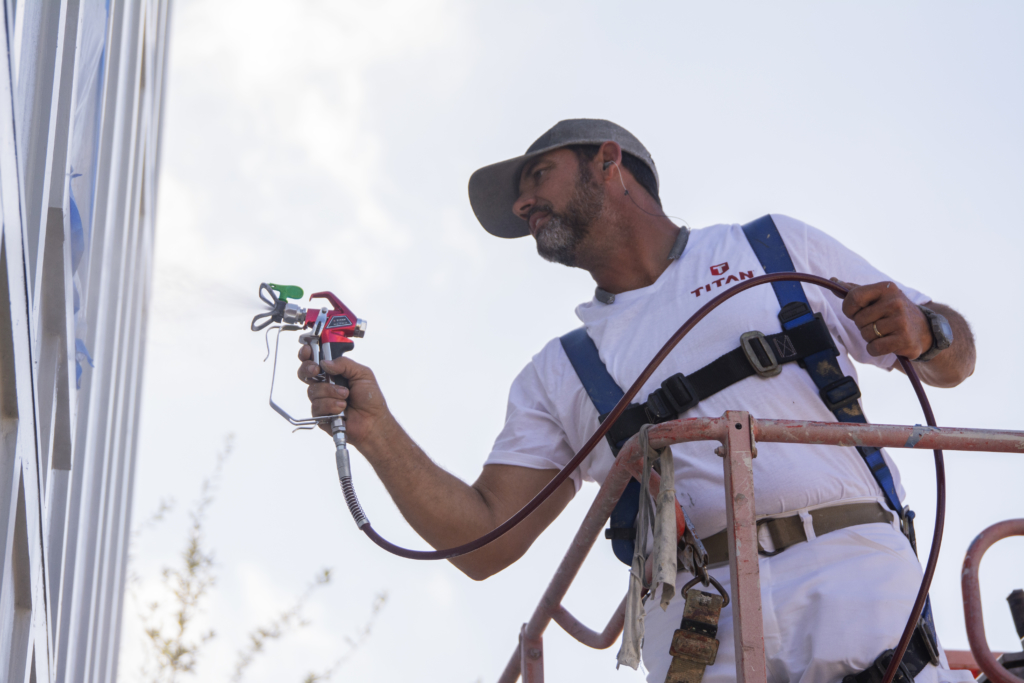Spray tip selection
 If you’ve been a paint contractor for any number of years, you understand that for all intents and purposes, tips are the ‘brains’ of airless paint systems. They control just about everything from the width of the spray pattern and paint flow rate to regulating how hard the pump needs to work. Results can vary widely depending on which tip is used, so choosing the right one for the job is really important.
If you’ve been a paint contractor for any number of years, you understand that for all intents and purposes, tips are the ‘brains’ of airless paint systems. They control just about everything from the width of the spray pattern and paint flow rate to regulating how hard the pump needs to work. Results can vary widely depending on which tip is used, so choosing the right one for the job is really important.
As a manufacturer of sprayers and tips, we field many questions from professional painting contractors about tips. In recent months, we’ve seen a significant uptick in the number of questions related to advancements in low-pressure technology. Given that, we’ve compiled some general guidelines about choosing tips that can benefit newbies as well as the seasoned pros responsible for training those newcomers.
FINE-FINISH AIRLESS TIPS
Specialty tips for super-fine atomization and precise control at lower pressures when spraying stains, lacquers, varnishes, urethanes and clear topcoats. When used correctly, fine-finish airless tips produce a deeper, glass-like shine. With double orifices (a pre-orifice and a finish orifice), coatings are atomized twice, producing smaller droplet sizes.
■ Types of jobs: cabinetry, trim, doors, crown molding
■ Coatings: stains, lacquers, sealers, enamels
■ Orifice sizes: .008″ to .014″
■ Numbers: last digit is always even (308, 310, 312, 314, etc.)
■ Fan pattern: 4″ to 12″
Pro comment: For decorative and faux-finish painter Tom Henman of Lancaster, PA’s Decorative Painting, LLC, fine-finish airless tips are the workhorse of his spray-tip arsenal. “I do a lot of lacquer cabinets,” says Henman, “and nothing beats the finish you can achieve with a fine-finish airless tip. I like the 310 size. I keep the pressure down low and get a nice 6″- to 8″-wide pattern. The ability to control the paint and airflow is key to getting a great finish and minimizing overspray.” In addition to lacquers, he also uses the tip for metallics and enamel finishes.
STANDARD AIRLESS TIPS
Traditionally, these are the most common tips used by paint contractors (though this is changing due to advancements in low-pressure tips … more on that below). Available in the broadest range of sizes, standard airless tips are all-purpose, single-orifice tips. Typically, the least expensive of tips, there are two types: high-quality standard tips (such as the Titan SC-6+) and premium standard tips (such as the Titan TR1). Premium standard tips are the best overall performing standard tip, as they hold the fan pattern wider longer.
■ Types of jobs: decks, doors, Sheetrock, interior walls and ceilings, exteriors, cinder blocks, stucco
■ Coatings: stains, lacquers, enamels and oil- and water-based house paints, as well as extremely thick block filler, joint compound and waterproofing coatings
■ Orifice sizes: widest range of sizes: .007″ to .055″
■ Numbers: last digit is always odd (313, 415, 517, etc.)
■ Fan pattern: widest range: 2″ to 24″
Pro comment: The bulk of Minneapolis-based Headwaters Painting’s work is in the residential and interior sector. Ryan Turry relies on three spray rigs to get the work done and finds he turns to 515 and 517 tips for a lot of projects. “We try to keep things pretty simple,” says Turry. “The 515 and 517 are our go-to choice for exterior body work. They allow a higher volume of paint to go through the tip, which is needed when spraying thicker coatings. We also spray ceilings and use those same tips unless we’re using an oil-based primer.” For interior cabinet work, Turry notes he’ll switch out the tip for a fine-finish, low-pressure (FFLP) 310 or 312. “I call those our bread-and-butter tips for interior enamel work like cabinets, baseboards, doors and trim. The narrower spread and reduced overspray help keep things controlled and moving.”
LOW-PRESSURE, HIGH-EFFICIENCY AIRLESS (HEA) TIPS
Spraying at pressures as low as 1000 PSI with the same production rates as standard tips, low-pressure HEA tips are replacing standard tips as the tip of choice for paint contractors. Benefits of these tips include minimal overspray, reduced paint consumption, less prep, and less wear and tear on sprayers. These tips are slightly more expensive than standard tips, but they last at least twice as long. Use the same tip sizes you would choose for jobs using standard tips.
■ Types of jobs: decks, doors, Sheetrock, exteriors, cinder blocks
■ Coatings: stains, lacquers, block filler, enamels and oil- and water-based house paints
■ Orifice sizes: .011″ to .021″
■ Numbers: last digit is always odd (313, 415, 517, etc.)
■ Fan pattern: 6″ to 12″
The advancement of low-pressure tip technology is really the most prominent change the industry has seen for 20+ years. In the past, many contractors viewed the pressure gauge as a speedometer—the higher the pressure, the higher the production rate. Low-pressure tips have drastically changed that perception, since spraying at 1000 PSI with a low-pressure HEA tip has the same production rate as a standard tip, but with the many benefits listed above. So, when does it still make sense to use a standard tip? We get this question a lot. Standard tips are the best choice when the job requires a longer hose length of 150′ to 300′ (the longer the hose, the less pressure there is at the gun), and when spraying thicker coatings that require larger tip sizes.
Here’s the bottom line: tips directly affect the quality of the finish, the success of your jobs, and your bottom line. Choose wisely!
Pro comment: Handling mostly commercial work, Matt Pisaeno of Pisaeno Painting & Construction, LLC in Clark, NJ is a big fan of HEA tips.
“We do a lot of 10,000—15,000-sq.-ft. spaces with door jambs numbering up to 45 or so,” says Pisaeno. “For that kind of work, HEAs are awesome. We use them on the walls and door jambs and boxes; just switching tip sizes as we go. We don’t have to bring in a second rig, and we save the time of cleaning up two rigs as well.” Pisaeno’s preference is a 211 or 213 for door jambs and a 417 or 419 for walls. “These are perfect for our applications, as there’s very little overspray,” he says. “Because our work is commercial, we don’t get to pick the product and, a lot of times, it’s expensive. The flexibility of the HEA and the ability to control overspray keeps my materials and time costs down and helps me win bids. Plus, the HEAs last twice as long as other tips. I’ll run 50 gallons of primer followed by 50 gallons of finish through one in a day with no problem. It maintains the same efficiency and quality spray pattern. Other tips start to waste product around the 50- or 60-gallon mark. Best of all, it levels out really nicely. No mess, less product used, great finish … everybody’s happy.”
__________________________________________________________________________________________
 Chris Noto is the director of professional products at Titan. He has been in the painting business for 27 years in sales, training and product-development functions.
Chris Noto is the director of professional products at Titan. He has been in the painting business for 27 years in sales, training and product-development functions.




